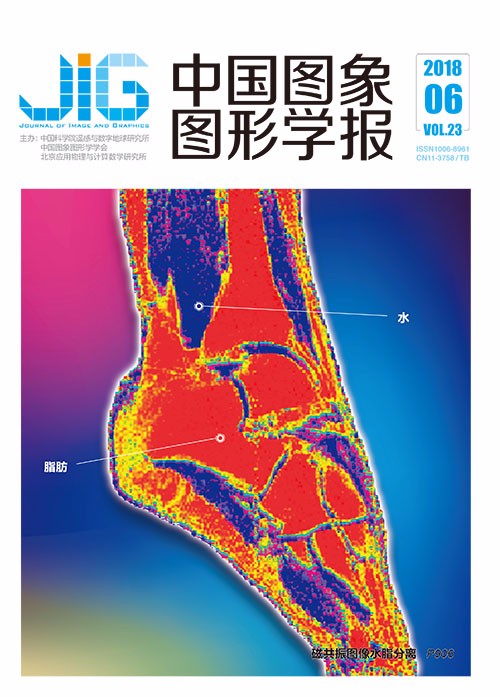
背景吸收的马尔可夫显著性目标检测
蒋峰岭1,2, 张海涛3, 杨静1, 孔斌1(1.中国科学院合肥物质科学研究院智能机械研究所, 合肥 230031;2.合肥师范学院计算机学院, 合肥 230061;3.合肥工业大学计算机与信息学院, 合肥 230009) 摘 要
目的 现有的基于马尔可夫链的显著目标检测方法是使用简单线性迭代聚类(SLIC)分割获得超像素块构造图的节点,再将四边界进行复制获得吸收节点,但是SLIC分割结果的好坏直接影响到后续结果,另外,很大一部分图像的显著目标会占据12个边界,特别是对于人像、雕塑等,如果直接使用四边界作为待复制的节点,必然影响最终效果。针对以上存在的缺陷,本文提出一种背景吸收的马尔可夫显著目标检测方法。方法 首先通过差异化筛选去除差异较大的边界,选择剩余3条边界上的节点进行复制作为马尔可夫链的吸收节点,通过计算转移节点的吸收时间获得初始的显著图,从初始显著图中选择背景可能性较大的节点进行复制作为吸收节点,再进行一次重吸收计算获得显著图,并对多层显著图进行融合获得最终的显著图。 结果 在ASD、DUT-OMRON和SED 3个公开数据库上,对比实验验证本文方法,与目前12种主流算法相比,在PR曲线、F值和直观上均有明显的提高,3个数据库计算出的F值分别为0.903、0.544 7、0.775 6,验证了算法的有效性。结论 本文针对使用图像边界的超像素块复制作为吸收节点和SLIC分割技术的缺陷,提出了一种基于背景吸收马尔可夫显著目标检测模型,实验表明,本文的方法适用于自底向上的图像显著目标检测,特别是适用于存在人像或雕塑等目标的图像,并且可以应用于图像检索、目标识别、图像分割和图像压缩等多个领域。
关键词
Image saliency detection based on background-absorbing Markov chain
Jiang Fengling1,2, Zhang Haitao3, Yang Jing1, Kong Bin1(1.Institute of Intelligent Machines, Hefei Institutes of Physical Science, Chinese Academy of Sciences, Hefei 230031, China;2.School of Computer Science and Technology, Hefei Normal University, Hefei 230061, China;3.School of Computer and Information, Hefei University of Technology, Hefei 230009, China) Abstract
Objective The method of saliency detection via absorbing Markov chain uses simple linear iterative cluster (SLIC) method to obtain superpixels as graph nodes. Then, a k-regular graph is constructed, and the edge weight is calculated by the difference of two nodes on CIELAB value. The superpixels are duplicated on boundary as absorbing nodes. Then, the absorbed time of transient nodes on the Markov chain is calculated. If the absorbed time is small, then the transient node is similar to the absorbing node, which is possibly a background node. On the contrary, the transient node is dissimilar to the absorbing node when the absorbed time is large. Then, the node is a salient node. Actually, the number of superpixels obtained by using the SLIC method influences the results of the saliency maps. If the size of the superpixel is extremely large, then the detailed information is ignored. On the contrary, if the size of the superpixel is extremely small, then the global cue is missed. The saliency objects usually occupy one or two boundaries of images, especially for portraits and sculptures. The final saliency results are influenced when four boundary nodes are duplicated as absorbing nodes. Considering these drawbacks, we propose an improved method based on background nodes as absorbing nodes on absorbing Markov chain. Multilayer image fusion is used to restrain the influence of the uncertain number of superpixels through the SLIC method. Method First, we confirm the edge selection. We separately obtain the four boundaries of the image nodes by SLIC method, duplicate them as absorbing nodes, and obtain four types of saliency maps. Then, we calculate the difference values of two saliency maps. The largest value of one saliency map is computed and compared with those of the other three maps. Then, we remove the most different edge and continue to use the remaining three boundary nodes to be duplicated as absorbing nodes. Then, the initial saliency map can be obtained by calculating the absorbed time of the transient nodes to absorbing nodes at the absorbing Markov chain. Second, to further optimize the algorithm, the number of absorbing nodes should be increased. In addition, the background may be a part of the boundary nodes. We add other nodes that are probably background nodes, which are selected from the initial saliency map by a threshold. If the initial saliency value of the node is lower than the threshold, then the node is considered a background node. The selected boundary and background nodes are duplicated as absorbing nodes, by which the absorbed time of the transient nodes are calculated. The pixel saliency value can be obtained from the saliency value of the superpixels. Finally, we fuse the multiple pixel saliency maps and calculate the average values as the final results. The multiple saliency values are obtained via different numbers of superpixels by using the SLIC method. Result We evaluate the effectiveness of our method on the following three benchmark datasets: ASD, DUT-OMRON, and SED. We compare our method with 12 recent state-of-art saliency detection methods, namely, MC, CA, FT, SEG, BM, SWD, SF, GCHC, LMLC, PCA, MS, and MST. ASD contains 1 000 simple images. DUT-OMRONS contains 5 168 complex images. SED includes 200 images, in which 100 images have one salient object, and the other 100 images have two salient objects. The experimental results show that the improved algorithm is efficient and better than the 12 state-of-the-art methods in precision recall curves (PR-curve) and F-measure. The precision is calculated as the ratio of actual saliency results assigned to all predicted saliency pixels. Recall is defined as the ratio of the total saliency captured pixels to the ground-truth number. F-measure is an overall performance measurement. Some visual comparative examples selected from three datasets are shown intuitively. The F-measure values of the three benchmark databases are 0.775 6, 0.903, and 0.544 7. These values are higher than that of the other 12 methods. Conclusion The image can be segmented into complex background, and the partition of human eyes is interesting. The visual image saliency detection extracts the portion of interest through the computer simulation as a human visual system. We propose an improved model, which is based on the background nodes and image fusion, to obtain the final results given the drawbacks of using four image boundaries to be duplicated as absorbing nodes and the uncertain number of superpixels through the SLIC method. The experiments show that the method is efficient and can be applicable to the bottom-up image saliency detection, especially for images such as portraits or sculptures. It can also be applied to many fields, such as image retrieval, object recognition, image segmentation, and image compression.
Keywords
|



 中国图象图形学报 │ 京ICP备05080539号-4 │ 本系统由
中国图象图形学报 │ 京ICP备05080539号-4 │ 本系统由